Learn about the causes, diagnosis, and treatment options for this rare genetic disorder.
Ataxia Telangiectasia is often diagnosed in adolescence or adulthood, presents unique challenges and requires specialized care.
Living with unwanted veins is a thing of the past, when you can simply schedule a free consultation with Vein Center Doctor and find your ideal solution today.
Understanding Late-Onset Ataxia Telangiectasia

Late-onset Ataxia Telangiectasia (AT) is a rare genetic disorder that affects the nervous and immune systems. Unlike classic AT, which typically appears in early childhood, late-onset AT emerges during adolescence or adulthood.
What are the Symptoms of Late-Onset Ataxia Telangiectasia?
While symptoms vary, individuals with late-onset AT may experience:
- Gait instability: Difficulty walking and maintaining balance.
- Tremors: Involuntary shaking movements, often in the hands.
- Progressive Ataxia: Gradual loss of coordination and control over movements.
- Dystonia: Muscle contractions causing twisting and repetitive movements or abnormal postures.
- Choreoathetosis: Involuntary, irregular, unpredictable muscle movements.
Important Note: It’s crucial to remember that these are just some potential symptoms. The specific presentation and severity of late-onset AT can differ significantly from person to person.
What Causes Late-Onset Ataxia Telangiectasia?
Late-onset AT is caused by mutations in the ATM gene, which is responsible for repairing damaged DNA. Individuals with this condition have two mutated copies of the ATM gene (biallelic pathogenic variants).
Interestingly, some individuals with late-onset AT retain a small amount of ATM protein activity, which may contribute to milder symptoms and slower disease progression.
How is Late-Onset Ataxia Telangiectasia Diagnosed?
Diagnosing late-onset AT involves a comprehensive evaluation that may include:
- Physical and Neurological Examination: Assessing for characteristic symptoms like ataxia, dystonia, and tremors.
- Genetic Testing: Identifying mutations in the ATM gene.
- Blood Tests: Measuring alpha-fetoprotein (AFP) levels, which are often elevated in individuals with AT.
What are the Challenges of Diagnosing Late-Onset Ataxia Telangiectasia?

Diagnosing late-onset AT can be challenging due to:
- Variable Symptom Onset: Symptoms may not appear until adulthood, making it difficult to connect them to AT.
- Overlapping Symptoms: Late-onset AT can share symptoms with other neurological conditions.
- Milder Symptoms: Some individuals experience subtle symptoms that may be initially overlooked.
Living with Late-Onset Ataxia Telangiectasia: Management and Support
While there’s no cure for late-onset AT, various strategies can help manage symptoms and improve quality of life.
What are the Treatment Options for Late-Onset Ataxia Telangiectasia?
Treatment for late-onset AT focuses on symptom management and addressing individual needs. Options may include:
- Physical Therapy: Improves coordination, balance, and mobility.
- Occupational Therapy: Helps individuals adapt to daily living challenges.
- Speech Therapy: Addresses speech and swallowing difficulties.
- Medications: May be prescribed to manage specific symptoms, such as tremors or dystonia.
- Cancer Screening: Regular checkups to monitor for potential malignancies due to an increased cancer risk in individuals with AT.
- Immunological Support: May be necessary for individuals experiencing immune deficiencies.
What are Some Tips for Managing Late-Onset Ataxia Telangiectasia?
In addition to medical interventions, here are some practical tips for managing late-onset AT:
- Assistive Devices: Explore the use of canes, walkers, or wheelchairs to improve mobility.
- Home Modifications: Make your home safer and more accessible with ramps, grab bars, and non-slip surfaces.
- Lifestyle Adaptations: Adjust activities and routines to conserve energy and minimize stress on the body.
- Support Groups: Connect with others facing similar challenges for emotional support and shared experiences.
What is the Role of Research in Late-Onset Ataxia Telangiectasia?
Ongoing research is vital for:
- Understanding Disease Mechanisms: Identifying how specific ATM gene mutations affect symptom severity and progression.
- Developing Targeted Therapies: Exploring treatments that address the underlying genetic causes of AT.
- Improving Diagnostic Tools: Creating more sensitive and specific tests for early detection and accurate diagnosis.
Vein Center Doctor: Your Partner in Vascular Health

While Vein Center Doctor specializes in vein treatment, we understand the interconnectedness of the body’s systems. We’re committed to providing comprehensive, patient-centered care and empowering our patients with knowledge. If you’re seeking information about late-onset AT or other health concerns, please don’t hesitate to contact us. We’re here to support you on your journey to optimal health and well-being.
Schedule a Consultation Today!
Dr. Sood at Vein Center Doctor is always happy to offer free consultations to anyone looking to understand their vein issues. Don’t spend another day wondering how to make those visible veins go away. Call us at 862-227-1143 today!







